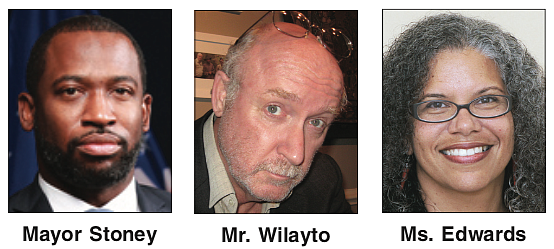City Council expected to provide $300,000 ‘seed money’ for planned slavery museum in Shockoe Bottom
Jeremy M. Lazarus | 1/6/2022, 6 p.m.
Richmond is poised to pour $300,000 into a new attempt to create a national slavery museum.
Mayor Levar M. Stoney, with support from a City Council majority, has proposed providing the money to establish a foundation to take on development of the museum. The foundation’s leadership likely would include former members of the city’s defunct Slave Trail Commission, including Richmond Delegate Delores L. McQuinn and the Revs. Benjamin P. Campbell and Sylvester T. Turner.
The mayor, who expects City Council to endorse the funding at its next meeting on Monday, Jan. 10, described the $300,000 as “seed money” to get the foundation on its feet in the effort to create the museum near the site of infamous Lumpkin’s Jail, next door to Main Street Station in Shockoe Bottom.
Notably, the foundation would be charged with raising the projected $200 million to $220 million needed to complete and fill the museum.
The city and state already have set aside about $40 million to support development of projects involving slave history, but the rest would need to come from private sources, city officials have said.
The proposal is a second attempt to create a Virginia hub for education about slavery and enslaved people. Former Virginia Gov. L. Douglas Wilder was unsuccessful in the attempt to develop a $100 million slavery museum in Fredericksburg. That effort folded in 2011.
Despite claims that Richmond’s would be the first such museum, at least six existing museums feature significant exhibits focusing on slavery. The largest is the Smithsonian’s National Museum of African American History and Culture in Washington. Others are the Old Slave Mart in Charleston, S.C., and the Lest We Forget Museum of Slavery in Philadelphia.
Others include the Center for Reconciliation in Providence, R.I., the Whitney Plantation museum in Edgard, La., and the Charles H. Wright Museum of African American History in Detroit, as well as a the National Underground Railroad Freedom Center in Cincinnati.
Some of the staunchest advocates for development of a memorial park to the more than 300,000 enslaved people who were bought and sold in the slave markets of Richmond are not thrilled about the museum.
Phil Wilayto and Ana Edwards, who have for more than 17 years led the charge to preserve and protect Shockoe Bottom’s history as the nation’s second large slave market, are concerned that focus on a hugely expensive museum will sop up all the money to develop a 9-acre memorial to the enslaved that they have pushed for.
Mr. Wilayto believes that the renovated, but now largely unused train shed at the Main Street Station could more easily and less expensively become the museum’s home and leave resources for the memorial campus development.
City Hall appears to be struggling to move ahead to create the Enslaved African Heritage Campus, which the mayor in 2020 indicated was being fast-tracked. City Council in September 2020 approved the mayor’s plan to provide $1.7 million to kick start the development of that project, which is to include the museum and Lumpkin’s Jail areas west of the train tracks.
The campus also is to include the African Burial Ground north of Broad Street that was the nation’s first municipal burial ground for free and enslaved people, and several blocks east of the train tracks between Broad, 17th and Franklin streets that nestle the historic, but largely vacant Farmers’ Market.
So far, none of the $1.7 million has been spent, according to Sharon Ebert, the city’s deputy chief administrative officer for economic and community development. Nor has the city acquired any of the private property that is included in a city-operated parking lot located between the train tracks, at Broad and 17th streets, a key element of the expanded campus, Ms. Ebert stated in an email response to a Free Press query.
The city also has “not contacted or advanced the purchase” of the former Loving’s Produce distribution building, she stated, though that had been listed as a potential site for a new parking deck for the heritage campus and the nearby businesses.
According to Ms. Ebert, the city’s next step for the campus’ creation would be to spend up to $2.7 million to pay a firm to design the heritage campus. A request for proposals is to be released in the coming months to begin the process, she stated.
The funding would come from the $1.7 million, plus an additional $1 million City Council also is poised to approve at its next meeting.
The decision appears to have been made without any consultation with Mr. Wilayto, Ms. Edwards or any other advocates or organizations. They created the vision for the campus and persisted for more than a decade to secure the support of the mayor and council.
“We are committed to a Shockoe heritage campus,” Mayor Stoney has insisted in rejecting concerns. That includes the full campus as well as the museum, he said.
“A heritage and interpretive center or museum will give us the opportunity to create a space that serves as a site of conscious memorialization, reflection, education and atonement,” he said.







